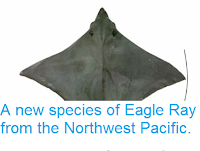The Potamotrygonidae are a unique group of Freshwater Stingrays found in the rivers of South America. They were originally thought to have colonised the continent from the Atlantic, since they are found only in rivers that drain into that ocean. However genetic studies have suggested that these Rays are in fact more closely related to Pacific species, and that the species found furthest west (i.e. upstream) are more closely related to marine species than those further downstream, suggesting that the first colonists had come from the Pacific, and that the invasion of South America must therefore have occurred before the rise of the Andes Mountains. This was a surprising conclusion, and provoked scientists to look for more evidence. One place where this was found was in the Tapeworms (Cestoda) that infect the intestines of these Rays, which were found to follow the same genetic pattern, with species found furthest from the sea most closely related to their marine relatives. Because these Rays appeared to have invaded the continent before the rise of the Andes, they were for a long time presumed to have no close relatives in the seas, however, recent studies of the Indo-Pacific Stingsay genus Himantura revealed that two species previously assigned to it were in fact more closely related to the Freshwater Stingrays of South America; so closely related, in fact, that they were placed in a new genus, Styracura within the family Potamotrygonidae, the first marine Rays assigned to this group.
In a paper published in the journal Zootaxa on 3 August 2017, Bruna Trevisan and Fernando Marques of the Laboratório de Helmintologia Evolutiva at the Universidade de São Paulo describe a new species of Cestode Tapeworm from the intestine of the Caribbean Whiptail Stingray, Styracura schmardae, one of the two species of marine Potamotrygonid.
Tapeworms are parasitic Flatworms that live in the digestive
tracts of Vertebrate hosts, attaching themselves to the intestine wall
and absorbing nutrients through their skins. Adult Tapeworms engage in
sexual reproduction, producing eggs which are passed out of the host in
its feces. Juvenile Tapeworms often inhabit one or more intermediate
hosts before reaching their final adult stage, growing in the gut till
they reach a certain size, then migrating to other tissues where they
form cysts, becoming dormant till the animal dies and is eaten by the
next host in the life-cycle.
The new species is placed in the genus Rhinebothrium, which is found in a wide range of Batoids, and given the specific name reydai, in honour of Florian Reyda, an expert on Cestodes who took part in the expedition to the Caribbean coast of Panama that recovered the Stingrays from which this species was first discovered. The species was found living in five Stingrays caught off the coast of Almirante in Bocas Del Toro Province. The Worms were up to 7.4 mm in length with as many s 64 segmants, and were attached to the lining of the intestine by s scolex ('head') with four stalked, bilobed bothridia (suckers).
Scanning electron micrograph showing the scolex of Rhinebothrium reydai. Trevisan &Marques (2017).
See also...
Follow Sciency Thoughts on Facebook.







